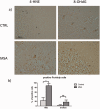Decreased Coenzyme Q10 Levels in Multiple System Atrophy Cerebellum
- PMID: 27235405
- PMCID: PMC4913434
- DOI: 10.1093/jnen/nlw037
Decreased Coenzyme Q10 Levels in Multiple System Atrophy Cerebellum
Abstract
In familial and sporadic multiple system atrophy (MSA) patients, deficiency of coenzyme Q10 (CoQ10) has been associated with mutations in COQ2, which encodes the second enzyme in the CoQ10 biosynthetic pathway. Cerebellar ataxia is the most common presentation of CoQ10 deficiency, suggesting that the cerebellum might be selectively vulnerable to low levels of CoQ10 To investigate whether CoQ10 deficiency represents a common feature in the brains of MSA patients independent of the presence of COQ2 mutations, we studied CoQ10 levels in postmortem brains of 12 MSA, 9 Parkinson disease (PD), 9 essential tremor (ET) patients, and 12 controls. We also assessed mitochondrial respiratory chain enzyme activities, oxidative stress, mitochondrial mass, and levels of enzymes involved in CoQ biosynthesis. Our studies revealed CoQ10 deficiency in MSA cerebellum, which was associated with impaired CoQ biosynthesis and increased oxidative stress in the absence of COQ2 mutations. The levels of CoQ10 in the cerebella of ET and PD patients were comparable or higher than in controls. These findings suggest that CoQ10 deficiency may contribute to the pathogenesis of MSA. Because no disease modifying therapies are currently available, increasing CoQ10 levels by supplementation or upregulation of its biosynthesis may represent a novel treatment strategy for MSA patients.
Keywords: Cerebellar ataxia; Coenzyme Q10; Multiple system atrophy; Oxidative stress.
© 2016 American Association of Neuropathologists, Inc. All rights reserved.
Figures





References
-
- Lin DJ, Hermann KL, Schmahmann JD. Multiple system atrophy of the cerebellar type: Clinical state of the art. Mov Disord 2014;29:294–304 - PubMed
-
- Multiple-System Atrophy Research Collaboration. Mutations in COQ2 in familial and sporadic multiple-system atrophy. New Eng J Med 2013:369;233–44 - PubMed
-
- Lin CH, Tan EK, Yang CC, et al. COQ2 gene variants associate with cerebellar subtype of multiple system atrophy in Chinese. Mov Disord 2015;30:436–7 - PubMed
-
- Chen YP, Zhao B, Cao B, et al. Mutation scanning of the COQ2 gene in ethnic Chinese patients with multiple-system atrophy. Neurobiol Aging 2015;36:1222.e7–11 - PubMed
Publication types
MeSH terms
Substances
Supplementary concepts
Grants and funding
LinkOut - more resources
Full Text Sources
Other Literature Sources
Medical

